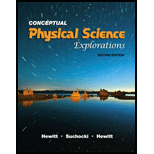
The number of electrons shared in a double covalent bond.
Answer to Problem 14RQ
Four electrons are shared in a double covalent bond or Two electrons from each atom are shared in a double covalent bond.
Explanation of Solution
The atoms of the same elements or the atoms of elements having very less electronegativity difference tend to share the electrons for the bond formation. They undergo a mutual sharing of electron between them and form a typical bond called a covalent bond. Thus a covalent bond is a type of bond where atoms are held together by the mutual attraction of a shared pair of electrons.
When the two atoms tend to combine and mutually share one electron each, they make a single covalent bond. Similarly, when the two atoms tend to combine and mutually share two electrons each, they make a double covalent bond. Thus, the double covalent bond or double bond is a bond formed by the mutual sharing of four electrons between them.
Conclusion:
Therefore, total four electrons or two electrons from each atom are shared in a double covalent bond.
Chapter 18 Solutions
Conceptual Physical Science Explorations
Additional Science Textbook Solutions
University Physics with Modern Physics (14th Edition)
Physics for Scientists and Engineers with Modern Physics
Physics: Principles with Applications
College Physics
College Physics (10th Edition)
An Introduction to Thermal Physics
 College PhysicsPhysicsISBN:9781305952300Author:Raymond A. Serway, Chris VuillePublisher:Cengage Learning
College PhysicsPhysicsISBN:9781305952300Author:Raymond A. Serway, Chris VuillePublisher:Cengage Learning University Physics (14th Edition)PhysicsISBN:9780133969290Author:Hugh D. Young, Roger A. FreedmanPublisher:PEARSON
University Physics (14th Edition)PhysicsISBN:9780133969290Author:Hugh D. Young, Roger A. FreedmanPublisher:PEARSON Introduction To Quantum MechanicsPhysicsISBN:9781107189638Author:Griffiths, David J., Schroeter, Darrell F.Publisher:Cambridge University Press
Introduction To Quantum MechanicsPhysicsISBN:9781107189638Author:Griffiths, David J., Schroeter, Darrell F.Publisher:Cambridge University Press Physics for Scientists and EngineersPhysicsISBN:9781337553278Author:Raymond A. Serway, John W. JewettPublisher:Cengage Learning
Physics for Scientists and EngineersPhysicsISBN:9781337553278Author:Raymond A. Serway, John W. JewettPublisher:Cengage Learning Lecture- Tutorials for Introductory AstronomyPhysicsISBN:9780321820464Author:Edward E. Prather, Tim P. Slater, Jeff P. Adams, Gina BrissendenPublisher:Addison-Wesley
Lecture- Tutorials for Introductory AstronomyPhysicsISBN:9780321820464Author:Edward E. Prather, Tim P. Slater, Jeff P. Adams, Gina BrissendenPublisher:Addison-Wesley College Physics: A Strategic Approach (4th Editio...PhysicsISBN:9780134609034Author:Randall D. Knight (Professor Emeritus), Brian Jones, Stuart FieldPublisher:PEARSON
College Physics: A Strategic Approach (4th Editio...PhysicsISBN:9780134609034Author:Randall D. Knight (Professor Emeritus), Brian Jones, Stuart FieldPublisher:PEARSON





